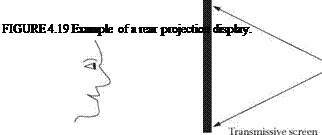This technology is used in home cinema, in office and business applications, and in conference and education settings. The technologies have a number of disadvantages including a short lamp life span of the components. Compared to the other technologies described above, these give little contrast and luminance and are sensitive to the effects of ambient light. When someone stands between the projected image source and the screen, he or she casts a shadow onto the screen.
4.5.3.1 rear projection Displays
In rear projection, the projector is positioned behind the screen, projecting the image onto the reverse side of the screen. The screen then transmits the projected image to the front surface of the screen and the viewers see the projected image on the front of the screen (Figure 4.19).
By its nature, a rear projection screen is a transmitting screen. It is therefore more resistant to ambient light; ambient light shining onto the screen will in principle not wash out the image but instead be transmitted through the screen. Almost all rear projection screens actually show some influence of ambient light. However, it is a fact that rear projection provides a much higher contrast ratio than front projection (typical values are 10 times higher contrast ratio than front projection). In addition to the contrast advantage, the rear projection technology also allows the operators to be located extremely close to the screen, since there is no possibility of shading of the image. One drawback of rear projection is that a certain space behind the screen is needed to house the projector. Therefore, the location of this technology needs to make allowance for the required distance from projector to screen. Often one or two [9]

 |
Typical set-up
mirrors (depending on the projector optics) are used to ‘fold the light path’, thereby reducing the build-in depth (Figure 4.20).
There are three basic different designs of rear projection display wall:
1. A stand-alone device—That is, one projector projecting onto one screen.
2. A custom-built display wall—A number of projectors are positioned in a mechanical structure projecting onto the screen.
3. A cube display wall—A number of display cubes (each containing projector and screen) is tiled to form the display wall.



